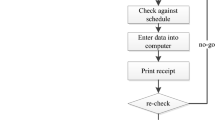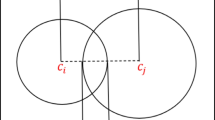Abstract
This paper presents a novel integer linear programming model for designing multi-floor layout of cellular manufacturing systems (CMS). Three major and interrelated decisions are involved in the design of a CMS; namely cell formation (CF), group layout (GL), and group scheduling (GS). A novel aspect of this model is concurrently making the CF and GL decisions to achieve an optimal design solution in a multi-floor factory. Other compromising aspects are: multi-floor layout to form cells in different floors is considered, multi-rows layout of equal area facilities in each cell is allowed, cells in flexible shapes are configured, and material handling cost based on the distance between the locations assigned to machines are calculated. Such an integrated CMS model with an extensive coverage of important manufacturing features has not been proposed before and this model incorporates several design features including alternative process routings, operation sequence, processing time, production volume of parts, duplicate machines, machine capacity, new machine purchasing, lot splitting, material flow between machines, intra-cell layout, inter-cell layout, multi-floor layout and flexible configuration. The objective is to minimize the total costs of intra-cell, inter-cell, and inter-floor material handling, new machines purchasing and machine processing. Two numerical examples are solved by the Lingo software to verify the performance of the proposed model and illustrate the model features. Sensitive analysis is also implemented on some model parameters. An improved genetic algorithm (GA) is proposed to derive near-optimal solutions for the integrated model because of its NP hardness. It is then tested using several problems with different sizes and settings to verify the computational efficiency of the developed algorithm in comparison to a classic simulated annealing algorithm and the Lingo software. The obtained results show the efficiency of proposed GA in terms of objective function value and computational time.
Similar content being viewed by others
References
Wemmerlov U, Hyer NL (1986) Procedures for the part family/machine group identification problem in cellular manufacture. J Oper Manag 6:125–147
Wu X, Chu CH, Wang Y, Yue D (2007) Genetic algorithms for integrating cell formation with machine layout and scheduling. Comput Ind Eng 53:277–289
Salum L (2000) The cellular manufacturing layout problem. Int J Prod Res 38:1053–1069
Drira A, Pierreval H, Hajri-Gabouj S (2007) Facility layout problems: a survey. Annu Rev Control 31:255–267
Kochhar JS, Heragu SS (1998) MULTI-HOPE: a tool for multiple floor layout problems. Int J Prod Res 36(12):3421–3435
Hassan MMD (1994) Machine layout problem in modern manufacturing facilities. Int J Prod Res 32(11):2559–2584
Chen DS, Wang Q, Chen HC (2001) Linear sequencing for machine layouts by a modified simulated annealing. Int J Prod Res 39(8):1721–1732
Ficko M, Brezocnick M, Balic J (2004) Designing the layout of single and multiple-rows flexible manufacturing system by genetic algorithms. J Mater Process Technol 177–158:150–158
Montreuil B, Venkatadri U, Rardin RL (1999) Fractal layout organization for job shop environments. Int J Prod Res 37(3):501–521
Venkatadri U, Rardin RL, Montreuil B (1997) A design methodology for fractal layout organization. IIE Trans 29:911–924
Dimopoulos C, Zalzala AMS (2000) Recent developments in evolutionary computing for manufacturing optimization: problems, solutions and comparisons. IEEE Trans Evol Comput 68(2):93–113
Ho YC, Moodie CL (2000) A hybrid approach for concurrent layout design of cells and their flow paths in a tree configuration. Int J Prod Res 38:895–928
Akturk MS, Turkcan A (2000) Cellular manufacturing system design using a holonistic approach. Int J Prod Res 38:2327–2347
Lee SD, Chiang CP (2001) A cut-tree-based approach for clustering machine cells in the bidirectional linear flow layout. Int J Prod Res 39(3):491–512
Wang TY, Wu KB, Liu YW (2001) A simulated annealing algorithm for facility layout problems under variable demand in cellular manufacturing systems. Comput Ind 46:181–188
Wang S, Sarker BR (2002) Locating cells with bottleneck machines in cellular manufacturing systems. Int J Prod Econ 40(2):403–424
Chaieb I, Korbaa O (2003) Intra-cell machine layout associated with flexible production and transport systems. J Eng Manufact 217(7):883–897
Solimanpur M, Vrat P, Shankar R (2004) Ant colony optimization algorithm to the inter-cell layout problem in cellular manufacturing. Eur J Oper Res 157:592–606
Kim CO, Baek JG, Jun J (2005) A machine cell formation algorithm for simultaneously minimizing machine workload imbalances and inter-cell part movements. Int J Adv Manuf Technol 26(3):268–275
Chan FTS, Lau KW, Chan PLY, Choy KL (2006) Two-stage approach for machine-part grouping and cell layout problems. Robot Comput Integr Manuf 22:217–238
Ioannou G (2006) Time-phased creation of hybrid manufacturing systems. Int J Prod Econ 102:183–198
Wu X, Chu CH, Wang Y, Yan W (2007) A genetic algorithm for cellular manufacturing design and layout. Eur J Oper Res 181:156–167
Tavakkoli-Moghaddam R, Javadian N, Javadi B, Safaei N (2007) Design of a facility layout problem in cellular manufacturing systems with stochastic demands. Appl Math Comput 184:721–728
Mahdavi I, Mahadevan B (2008) CLASS: an algorithm for cellular manufacturing system and layout design using sequence data. Robot Comput Integr Manuf 24:488–497
Ahi A, Aryanezhad MB, Ashtianim B, Makui A (2009) A novel approach to determine cell formation, intracellular machine layout and cell layout in the CMS problem based on TOPSIS method. Comput Oper Res 36:1478–1496
Safaei N, Tavakkoli-Moghaddam R (2009) Integrated multi-period cell formation and subcontracting production planning in dynamic cellular manufacturing. Int J Prod Econ 120(2):301–314
Johnson RV (1982) SPACECRAFT for multi-floor planning. Manag Sci 28:407–417
Donaghey, C.E., Pire, V.F., 1991. Solving the facility layout problem with BLOCPLAN. Factory Automation and Information Management: Proceedings of a conference held at the University of Limerick, Limerick, Ireland, 649–658.
Bozer YA, Meller RD, Erlebacher SJ (1994) An improvement-type layout algorithm or single and multi-floor facilities. Manag Sci 40:918–932
Meller RD, Bozer YA (1996) A new simulated annealing algorithm for the facility layout problem. Int J Prod Res 34:1675–1692
Meller RD, Bozer YA (1997) Alternative approaches to solve the multi-floor facility layout problem. J Manuf Syst 16:192–203
Matsuzaki K, Irohara T, Yoshimoto K (1999) Heuristic algorithm to solve the multi-floor layout problem with the consideration of elevator utilization. Comput Ind Eng 36:487–502
Abdinnour-Helm S, Hadley SW (2000) Tabu search based heuristics for multi-floor facility layout. Int J Prod Res 38(2):365–383
Patsiatzis DI, Papageorgiou LG (2002) Optimal multi-floor process plant layout. Comput Chem Eng 26:575–583
Barbosa-Póvoa AP, Mateus R, Novais AQ (2002) Optimal 3D layout of industrial facilities. Int J Prod Res 40(7):1669–1698
Lee KY, Roh M-I, Jeong HS (2005) An improved genetic algorithm for multi-floor facility layout problems having inner structure walls and passages. Comput Oper Res 32:879–899
Lockwood WT, Mahmoodi F, Ruben RA, Mosier CT (2000) Scheduling unbalanced cellular manufacturing systems with lot splitting. Int J Prod Res 38:951–965
Süer GA, Saiz M, Gonzalez W (1999) Evaluation of manufacturing cell loading rules for independent cells. Int J Prod Econ 36:2185–2207
Defersha FM, Chen M (2006) A comprehensive mathematical model for the design of cellular manufacturing systems. Int J Prod Econ 103:767–783
Ballakur, A., 1985. An investigation of part family/machine group formation in designing a cellular manufacturing system, Ph.D. Thesis, University of Wisconsin, Madison, WI.
King J, Nakornchai V (1982) Machine-component group formation in group technology: review and extension. Int J Prod Res 20(2):117–133
Logendran R, Ramakrishna P, Sriskandarajah C (1994) Tabu search-based heuristics for cellular manufacturing systems in the presence of alternative process plans. Int J Prod Res 32:273–297
Holland JH (1975) Adaptation in natural and artificial system. Univ. of Michigan Press, Ann Arbor
Gen M, Cheng R (1997) Genetic algorithms and engineering design. Wiley, MA
Goldberg DE (1989) Genetic algorithms: in search, optimization & machine learning. Addison-Wesley, MA
Man KF, Tang KS, Kwong S (1999) Genetic algorithms: concepts and design. Springer, London
Author information
Authors and Affiliations
Corresponding author
Rights and permissions
About this article
Cite this article
Khaksar-Haghani, F., Kia, R., Mahdavi, I. et al. A genetic algorithm for solving a multi-floor layout design model of a cellular manufacturing system with alternative process routings and flexible configuration. Int J Adv Manuf Technol 66, 845–865 (2013). https://doi.org/10.1007/s00170-012-4370-2
Received:
Accepted:
Published:
Issue Date:
DOI: https://doi.org/10.1007/s00170-012-4370-2




